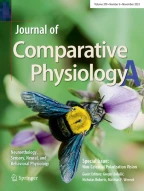Summary
In freely movingSalamandra salamandra various brain sites (n = 33) were stimulated monopolarly via chronically implanted electrodes. Stimulation of the optic tectum mainly elicited prey-catching behavior (mean lower current threshold Ilt = 9 μA) and sometimes predator-avoidance behavior (Ilt = 28 μA). Stimulation of the caudal dorsal (Ilt = 27 μA) or rostral dorsal thalamus (Ilt = 26 μA) exclusively released avoidance movements, such as ipsiversive turning, running, or moving backward. Telencephalic stimulation (Ilt = 66 μA) activated backward-creeping, trunk-raising, or jaw-opening/closing.
Brain lesions were produced inn = 64 fire salamanders either by anodal DC current, radiofrequency current, Kainic acid micro-injections, or micro-knife cuts. After ablation of the optic tectum, both visually guided prey-catching and predator-avoidance behaviors failed to occur. Unilateral lesions in the following prosencephalic brain areas caused a strong deficit of configurational prey-selection (‘disinhibition of prey-catching behavior’) and a failure of visual predator-avoidance behavior in response to stimuli moving in certain areas of the visual field: (i) caudal dorsal thalamus (entire contralateral visual field), (ii) rostral dorsal thalamus (frontal visual field of both eyes), and (iii) medial pallium (entire visual field of both eyes). Lesions in the lateral pallium led to a decrease in the threshold of visually guided predator-avoidance behavior.
Action potentials were extracellularly recorded from single tectal T5 neurons in intact animals and following various prosencephalic lesions (i), (ii), or (iii). In all of then = 14 investigated neurons the same alteration of response properties was obtained, corresponding to the change in behavior. Recordings from a single prey-selective class T5(1) neuron pre and post DC coagulation in the ipsilateral caudal dorsal thalamus produced: an increase in the diameter of the excitatory receptive field (ERF) from ≈30 ° to ≈50 ° and a strong deficit in selectivity with regard to moving configurational visual stimuli.
Similar content being viewed by others
Abbreviations
- ERF :
-
excitatory receptive field
- TP :
-
thalamicpretectal region
- MP :
-
medial pallium
- LP :
-
lateral pallium
- DC :
-
direct current
- IRM :
-
innate releasing mechanism
- IRME :
-
IRM extended or modified by experience
References
Burghagen H, Ewert J-P (1983) Influence of the background for discriminating object motion and self-induced motion in toadsBufo bufo (L). J Comp Physiol 152:241–249
Clairambault P (1976) Development in the prosencephalon. In: Llinás R, Precht W (eds) Frog neurobiology. Springer, Berlin Heidelberg New York, pp 924–945
Coyle JT (1978) Neuronal mapping with Kainic acid. TINS 11:132–135
Ewert J-P (1980) Neuroethology. Springer, Berlin Heidelberg New York
Ewert J-P (1983/84) Tectal mechanisms underlying prey-catching and avoidance behaviors in toads. In: Vanegas H (ed) Comparative neurology of the optic tectum. Plenum Press, New York (in press)
Ewert J-P, Burghagen H, Schürg-Pfeiffer E (1983a) Neuroethological analysis of the innate releasing mechanism for preycatching behavior in toads. In: Ewert J-P, Capranica RR, Ingle DJ (eds) Advances in vertebrate neuroethology. Plenum Press, New York London, pp 413–475
Ewert J-P, Finkenstädt Th, Weerasuriya A (1983b) Concepts for neuronal correlates of Gestalt perception: Visual prey recognition in toads. In: Aoki K, Morita H, Ishii S (eds) Animal behavior-physiological and ethological approaches. Japan Scientific Societies Press (JSSP), Tokyo
Finkenstädt Th (1983) Influence of the optic tectum and prosencephalic structures on visually controlled prey-catching and avoidance behaviors in the fire salamander. In: Ewert J-P, Capranica RR, Ingle DJ (eds) Advances in vertebrate neuroethology. Plenum Press, New York London, pp 585–594
Finkenstädt Th, Ewert J-P (1983) Processing of area dimensions of visual key stimuli by tectal neurons inSalamandra salamandra. J Comp Physiol 153:85–98
Finkenstädt Th, Ebbesson SOE, Ewert J-P (1983) Projections to the midbrain tectum ofSalamandra salamandra, Cell Tissue Res (in press)
Fritzsch B (1980) Retinal projections in European Salamandridae. Cell Tissue Res 213:325–341
Halpern M (1972) Some connections of the telencephalon of the frogRana pipiens. Brain Behav Evol 6:42–68
Herrick CJ (1927) The amphibian forebrain. IV. The cerebral hemispheres ofAmblystoma. J Comp Neurol 43:231–325
Herrick CJ (1933) The amphibian forebrain. VI.Necturus. J Comp Neurol 58:1–288
Herrick CJ (1948) The brain of the tiger salamander. University of Chicago Press, Chicago
Himstedt W, Fischerleitner E (1974) Farbencodierung in Retinaneuronen von Salamandern. Naturwissenschaften 61:220
Himstedt W, Tempel P, Weiler S (1978) Responses of salamanders to stationary visual patterns. J Comp Physiol 124:49–52
Jakway JS, Riss W (1972) Retinal projections in the tiger salamanderAmbystoma tigrinum. Brain Behav Evol 5:401–442
Kokoros JJ (1973) Efferent projections of the telencephalon in the toad (Bufo marinus) and tiger salamander (Ambystoma tigrinum). PhD Dissertation. Dept of Anatomy. Case Western Reserve University
Kokoros JJ, Northcutt RG (1977) Telencephalic efferents of the tiger salamanderAmbystoma tigrinum tigr. (Green). J Comp Neurol 173:613–628
Kuhlenbeck H (1921) Die Regionen des Anuren-Vorderhirns. Anat Anz 54:304–316
Lázár G (1978) Organization of the frog visual system. In: Lissak (ed) Recent developments of neurobiology in Hungary, vol VIII, Akademiai Kiado, Budapest, pp 9–50
Levine RL (1980) An autoradiographic study of the retinal projection inXenopus laevis with comparisons toRana. J Comp Neurol 189:1–29
Neary TJ, Wilczynski W (1980) Descending inputs to the optic tectum in Ranid Frogs. Neurosci Abstr 6:629
Northcutt RG (1981) Evolution of the telencephalon in nonmammals. Annu Rev Neurosci 4:301–350
Northcutt RG, Kicliter E (1980) Organization of the amphibian telencephalon. In: Ebbesson SOE (ed) Comparative neurology of the telencephalon. Plenum Press, New York
Scalia F (1976) The optic pathway of the frog: Nuclear organization and connections. In: Llinás R, Precht W (eds) Frog neurobiology. Springer, Berlin Heidelberg New York, pp 386–406
Ströer WFH (1940) Das optische System beim Wassermolch (Triturus taenatius). Acta Néerl Morphol 3:178–195
Trachtenberg MC, Ingle DJ (1974) Thalamo-tectal projections in the frog. Brain Res 79:419–430
Wilczynski W, Northcutt G (1977) Afferents to the optic tectum of the leopard frog. A HRP study. J Comp Neurol 173:219–230
Author information
Authors and Affiliations
Rights and permissions
About this article
Cite this article
Finkenstädt, T., Ewert, J.P. Visual pattern discrimination through interactions of neural networks: a combined electrical brain stimulation, brain lesion, and extracellular recording study inSalamandra salamandra . J. Comp. Physiol. 153, 99–110 (1983). https://doi.org/10.1007/BF00610347
Accepted:
Issue Date:
DOI: https://doi.org/10.1007/BF00610347
